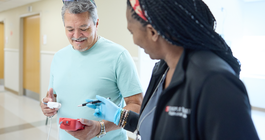
September 01, 2023
Removing shoes before entering a home is common in many countries around the world. According to a recent poll, the majority of Americans also prefer being shoeless when they’re relaxing in their home. But is it really necessary to take your shoes off at the door? Here’s a look at the health issues surrounding the practice to help you determine if it’s a habit you’d like to implement in your own home.
If you have kids old enough to play outdoors, you know it’s easy to track dirt into your home. Tracking in germs is just as easy.
In a 2008 study, new shoes were swabbed for bacteria after they’d been worn for two weeks. Coliform bacteria, including E. coli, were found on the outside of 96 percent of them.
Most coliform bacteria are harmless, but E. coli can cause intestinal and urinary tract infections. Their presence on the shoes indicated that the shoes had frequently contacted fecal matter, either from a restroom floor or from animal waste on an outdoor surface.
The study also found that the shoes were as good at passing on bacteria as they were at picking it up. They transferred bacteria to previously uncontaminated tiles at a rate of 90 to 99 percent.
Coliform aren’t the only bacteria hitching a ride on our footwear.
Infections from a type of bacteria called clostridium used to occur mostly in hospitals. To see how much the bacteria had migrated to other environments, University of Houston researchers sampled public areas, health care settings, and shoe soles in the U.S. and 12 other countries from 2014 through 2017. They found that 45 percent of the soles tested positive for C. diff, which causes inflammation of the colon and severe diarrhea.
In addition to bacteria, your shoes can pick up allergens like mold and pollen, as well as such harmful substances as lead, flame retardants, and pesticides.
While all these are good reasons not to wear shoes in your home, they aren’t as frightening as they sound.
The truth is, shoes aren’t the only items in your house loaded with bacteria. Your phone has more than 10 times the bacteria of most toilet seats. And your kitchen sponge is probably a better place than a laboratory petri dish to grow diverse communities of bacteria.
If you have a pet that goes outside, they’re tracking in germs regardless of what you do. And they’re less likely than you to avoid places where they’ll encounter a lot of germs.
The good news is that you typically need to contact a lot of bacteria in order to get ill.
Scientists have mixed opinions on the importance of taking off your shoes indoors.
Jinhee Jo, an author of the University of Houston study, says you should take them off “to help reduce the risk of catching C. difficile.” But Kevin Garey, an author on the same study, says “bacteria on shoes likely pose no or minimal risk” to healthy people.
Still, if you have young children who spend a lot of time on the floor, you may want to consider having a shoeless home. That’s also true if someone in your house has problems with their immune system. Having everyone take their shoes off before they enter a home won’t make the home germ-free, but it should reduce the number of germs everyone in the home encounters.
If going shoeless indoors seems like too much trouble, there are ways to reduce the risk of your shoes making you sick. One is to buy an antimicrobial doormat. Another is to clean your shoes periodically.
If you decide to implement a ditch-your-shoes-at-the-door policy, consider having some slippers or indoor shoes near your home’s entrance that you can easily change into. Just make sure they provide support and don’t have smooth soles. A study of older adults found that more half of their falls occurred when they were barefoot or only wearing socks or slippers.
It’s true that taking off your shoes when you walk in the house can reduce the levels of bacteria in your home. Whether that’s worth the added effort depends on your personal preferences and circumstances.